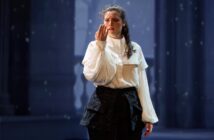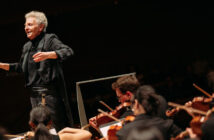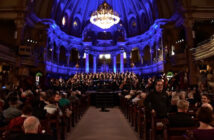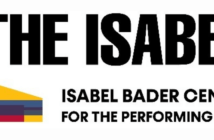
This page is also available in / Cette page est également disponible en:
![]() Francais (French)
Francais (French)
La Chapelle de Québec is one of the crown jewels of Canada’s classical music scene. The choir’s forces will be on full display when they join Les Violons du Roy to present Vivaldi’s Gloria, Carissimi’s Jepthe, and Buxtehude’s Jesu, meines Lebens Leben.
“When you look at the whole program, it might look a little bit like a mishmash, but actually the idea was to feature La Chapelle,” says Music Director Bernard Labadie, who will conduct the concerts on April 11 and 12 in Quebec City and on April 13 in Montreal. The repertoire selected for these performances is a feast for the choir, featuring moments of tricky counterpoint, intense contrasts, surging energy, and impressive restraint.
As a means of further highlighting the talents of the award-winning ensemble, all solos will be sung by members of the choir. This is a rare move for La Chapelle, but a logical one given that many of its choristers also enjoy careers as soloists. “Some of these people don’t sing in choruses elsewhere. They come to us because it’s just different. They don’t feel like they’re singing in a choir, they’re part of a special experiment,” says Labadie.
These sentiments ring true for soprano Marie Magistry, who has sung with the choir for 15 years and will be featured as a soloist in the Gloria and in Jepthe. “We are always treated with a lot of respect, as the experienced musicians that we are. We feel appreciated by the direction and administration, which makes us want to always give the organisation our best,” she says.
Labadie founded La Chapelle in 1985 with what he describes as a European model in mind. “There are not many choirs of this nature in North America,” he says. “La Chappelle is that rare example of a truly pan-Canadian choir. Most of our people are from Quebec, but we have a good contingent from Ontario, and now we have some people who live elsewhere and come back to us. It’s a choir that exists for only a certain number of weeks a year.”
Having such far-reaching membership means that time is of the essence when La Chapelle puts together concerts like this one. Typically, they rehearse a program for just two or three days prior to a performance. “It’s very, very focused work. It’s a choir that actually works like an orchestra,” says Labadie. Luckily, he has handpicked the singers for their skill and has an intimate knowledge of each of their voices. “Very often in rehearsal, I move people around a little bit to change the colour or the blend of the choir,” he says. “I get that personal in rehearsals, (to get) the sound that I want. I’m very hands-on.”
He will have a very clear vision of the sound he wants in these performances, as the works by Buxtehude and Carissimi are among Labadie’s personal favourites. Perhaps lesser-known to those who are not aficionados of baroque repertoire, Carissimi’s Jepthe holds a crucial place in the history of vocal music, being one of the earliest and finest extant examples of the oratorio. Written in 1650, it features all the floridity of the early baroque period and packs plenty of dramatic action into 24 fast-moving numbers.
Labadie says “(Jepthe) is a challenge that I’ve been thinking of throwing at (the choir) for quite a while.” Magistry explains one of the unique requirements of the piece, which is often written in complex six-part harmony: “You have to be able to step out as a soloist, seconds after performing a complicated fugue, which calls for a lot of concentration.” That hard work pays dividends in the oratorio’s exquisite conclusion, Plorate filii Israel. “The final chorus is one of the true masterpieces of 17th-century choral writing,” says Labadie. Magistry describes it as “extremely moving and dramatic,” adding that “everyone will be crying for sure!”
Labadie also has a particular affinity for the works of Dietrich Buxtehude, noting that the Danish composer served as a source of great inspiration for J.S. Bach. In fact, in 1705 Bach made a 400-kilometre journey—on foot—from Arnstadt to Lübeck to meet the master whom he so admired. “Any connection, for me, with Bach is always a bonus!” quips Labadie. He has high praise for the Buxtehude cantata on the program, from which Bach borrowed for the opening of his own fourth cantata, calling it a work of “transcendental beauty.”
The program concludes with a rendition of Vivaldi’s ever-popular Gloria, a ray of Easter sunshine to contrast the Lenten heft of Carissimi and Buxtehude. When compared with the atmosphere and technical challenge of the other pieces on the program, Labadie says that singing the Gloria is like “chewing gum” for La Chapelle. The piece has landed with a bright freshness on audience ears for more than three centuries.
Since stepping down from his role as music director of Les Violons du Roy in 2014, the opportunities for Labadie to work on projects that involved both Les Violons and La Chapelle have been limited. A busy international conducting schedule and his role as principal conductor of the Orchestra of St. Luke’s in New York City often keep him away from Quebec. All this to say, when he finds himself on the podium before these two renowned institutions of Canadian classical music, both of which he founded, “it always feels like I’m coming home.”
Les Violons du Roy, La Chapelle du Québec, Le Gloria de Vivaldi, April 11 &12 (Quebec City), April 13 (Montreal). www.violonsduroy.com
Playlist
This page is also available in / Cette page est également disponible en:
![]() Francais (French)
Francais (French)













